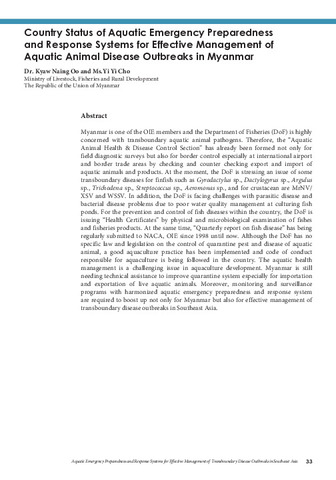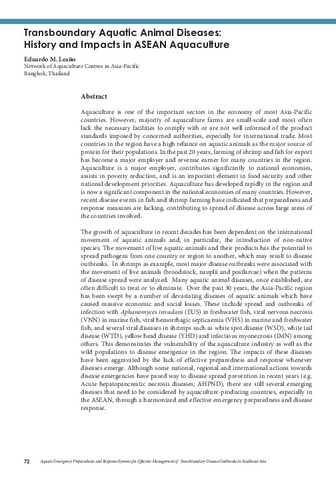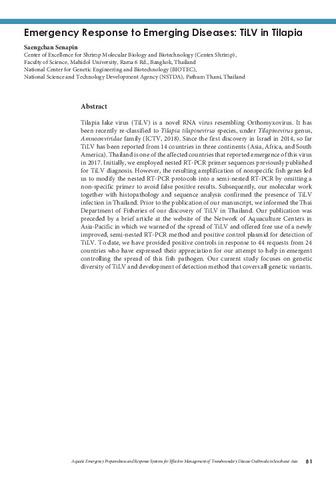Effect of iodine disinfection on the bacterial flora and hatching rate of grouper, Epinephelus coioides eggs at the cleavage and eyed stages
- Global styles
- MLA
- Vancouver
- Elsevier - Harvard
- APA
- Help

URL ที่เชื่อมโยง
eafp.orgวันที่
2001ผู้เขียน
Page views
2,539ASFA keyword
AGROVOC keyword
เมตาดาต้า
แสดงระเบียนรายการเต็มShare
นามธรรม
In this study, the effect of iodine disinfection on the bacterial flora and hatching rate of grouper egg at two different stages of development were investigated. The eggs (at cleavage and eyed stages) were soaked for 10 min in sterile seawater (control) and at different free iodine concentrations- 2.5, 5, 10, 15 and 20 ppm. Total bacterial and presumptive Vibrio count, as well as the hatching rate of the treated eggs were determined. Results showed that Vibrios are eliminated by iodine disinfection (2.5-20 ppm) but not by rinsing with sterile seawater. The total bacterial load and hatching rate of eggs decreased as the iodine concentration increased. Iodine concentrations of 15 and 20 ppm were effective in significantly reducing the total bacterial load of grouper egg at both the cleavage and eyed stages. However, at these concentrations the hatching rates were also significantly lower. Results also showed that grouper, Epinephelus coioides, eggs tolerate stress better at the eyed stage than at the cleavage stage.
การอ้างอิง
Tendencia, E. (2001). Effect of iodine disinfection on the bacterial flora and hatching rate of grouper, Epinephelus coioides eggs at the cleavage and eyed stages. Bulletin of the European Association of Fish Pathologists , 21(4), 160-163. http://hdl.handle.net/10862/1617
Type
ArticleISSN
0108-0288คอลเลกชัน
- Journal Articles [1249]
Except where otherwise noted, this item's license is described as http://creativecommons.org/licenses/by/2.5/scotland/
Related items
Showing items related by title, author, creator and subject.
-
Country status of aquatic emergency preparedness and response systems for effective management of aquatic animal disease outbreaks in Myanmar
Oo, Kyaw Naing; Cho, Yi Yi (Aquaculture Department, Southeast Asian Fisheries Development Center, 2019)Myanmar is one of the OIE members and the Department of Fisheries (DoF) is highly concerned with transboundary aquatic animal pathogens. Therefore, the Aquatic Animal Health & Disease Control Section has already been ... -
Transboundary aquatic animal diseases: History and impacts in ASEAN aquaculture
Leaño, Eduardo M. (Aquaculture Department, Southeast Asian Fisheries Development Center, 2019)Aquaculture is one of the important sectors in the economy of most Asia-Pacific countries. However, majority of aquaculture farms are small-scale and most often lack the necessary facilities to comply with or are not well ... -
Emergency response to emerging diseases: TiLV in tilapia
Senapin, Saengchan (Aquaculture Department, Southeast Asian Fisheries Development Center, 2019)Tilapia lake virus (TiLV) is a novel RNA virus resembling Orthomyxovirus. It has been recently re-classified to Tilapia tilapinevirus species, under Tilapinevirus genus, Amnoonviridae family (ICTV, 2018). Since the first ...






